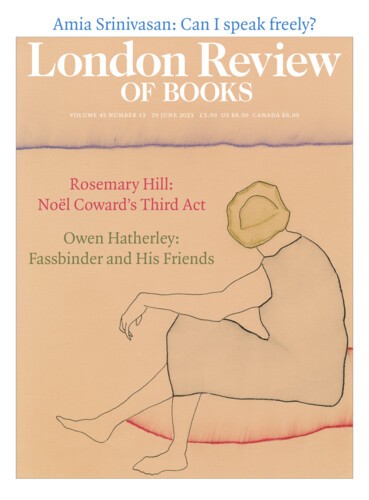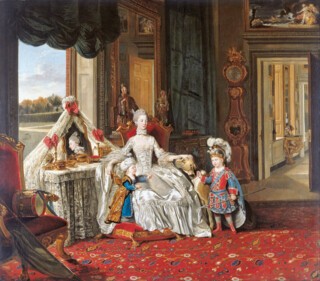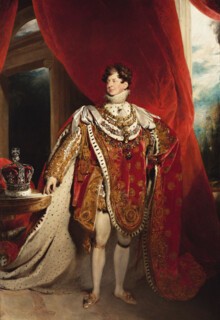If anyone could spark a craze for dresses the colour of ingested blood, it was Marie Antoinette. In 1775, so the story goes, Louis XVI saw her in a purplish-brown dress and christened it couleur de puce – the colour of a flea. Soon dresses were being made in shades of ventre de puce (flea’s belly) and cuisse de puce (flea’s thigh), names that evoke the erotic intimacy of a flea’s bite and perhaps even its subsequent itch. There must have been a certain thrill in making the flea – a source of discomfort shared by queens and commoners – into a fashion statement.
Just a few shades away from puce is a colour with quite different connotations. Royal purple suggests bloodlines rather than bloodstains. Fashions change, but monarchical regalia tends towards ossification: Charles III and Camilla left their coronation this year swathed in robes of ermine-trimmed purple, just as George III and his queen consort, Charlotte, did in 1761. Underneath her robes, Charlotte wore something more singular: her stomacher – the triangular panel covering the opening of the bodice – was encrusted with diamonds and valued at £60,000, the equivalent of more than £9.8 million today. At least it was recycled fashion: she had already worn it at her wedding to George two weeks earlier, having met him for the first time just hours beforehand.
Like Marie Antoinette, Charlotte was skewered by the press for her fondness for diamonds, though with much less dramatic consequences. Her reputation was not as a trendsetter but as a stickler for court protocol. At her insistence, enormous hoop skirts – the height of fashion when she was a child in the 1740s – continued to be worn at the British court until her death in 1818, rather like the skin-coloured tights prescribed for today’s royal women even at the height of summer. Antiquated traditions of court dress may have provided a semblance of stability as George III suffered from his periodic bouts of ‘madness’ and revolutions raged in America and France. But when George IV eventually dispensed with his mother’s old hoops, the ladies at court must have breathed a sigh of relief.
In less formal settings, Charlotte kept up with the latest styles in dress and hair. Four years after her coronation, she was painted by Johan Zoffany at her dressing table flanked by her two eldest sons: the fruits of her labours and the fulfilment of her duties as queen (she went on to have another thirteen children for good measure). The painting hinges on the intimacy of its central group: a mother gazes away from the spectator towards her eldest child while her fingertips touch the ‘leading strings’ attached to the costume of the younger. The boys are in fancy dress – the future George IV in classical garb as Telemachus, while his brother wears the turban and robes of a ‘Turk’. Charlotte, meanwhile, is dressed in white silk and lace. She is dressed for dinner with the king, but has paused at her toilette to attend to her children, while a maid hovers in the next room.
Zoffany’s portrait is a conversation piece (if toddlers can be said to make conversation), which purports to depict a private and natural familial scene, albeit one of public significance. Here, the dressing table is not a symbol of female vanity and artificiality (as it was for Hogarth or Swift) but denotes both royal splendour and orderliness, an attention to proper appearances. In the family grouping, Charlotte is a doting mother, but her reflection in the mirror on the dressing table is a disembodied profile, the reified image of a queen. She is surrounded by the riches of the world, from the Flemish lace on her dressing table to the Turkish carpet beneath her feet, the lacquered Chinese figurines in the background and even the imported flamingo on the English lawn in the garden outside. The power of the British Empire and the security of its future are here represented in the form of a family portrait, with the dutiful queen at its centre in a dress of spotless purity.
In Style and Society: Dressing the Georgians (until 8 October), shifting fashions are revealed through portraits, genre scenes, caricatures and surviving items of clothing and accessories. While the slant is towards elite dress (most pieces are from the Royal Collection), the exhibition casts its net widely. The foreign luxuries in Zoffany’s portrait were not only desirable status symbols; they also sparked anxious debate about the state of British manufacturing, the balance of trade and the nation’s moral rectitude. Imports of fashionable fabrics, such as Valenciennes lace and Lyons silk, were strictly controlled or banned by protectionist policies, even if, in practice, such laws were not always enforced. Charlotte’s silk dress was probably of domestic manufacture. As a show of support for Spitalfields weavers, she had mandated that only British-made silk be worn at court.
British fabrics also faced competition from printed calico cottons made in India and imported by the East India Company (the word ‘calico’ comes from the city of Calicut in Kerala). Their popularity helped to spark riots among silk and wool weavers in the late 17th and early 18th centuries. Women wearing cotton were dubbed ‘calico madams’ and attacked in the street, reportedly having their dresses ripped from their bodies. Many of these women were servants; their taste for foreign fashions was seen as an affront to class distinctions as well as to national self-sufficiency. Although the import and sale of Indian cotton was banned in Britain and France for much of the 18th century, it continued to be shipped via Britain to Africa, where some of it was bartered for slaves, and then on to the Caribbean. There, brightly coloured plaid ‘madras’ cottons became a staple of Creole fashion, worn by both the enslaved and the free. In the 1790s, madras cloths were incorporated into French high fashion in the wake of the Haitian revolution and the short-lived abolition of slavery in the French Republic’s colonies. Cotton was both a slave currency and a driver of the slave trade: by the end of the century, European demand had fuelled the establishment of cotton plantations across the Americas, as well as the growth of British weaving and printing industries that rivalled traditional centres of production in India.
In Britain, fashion was often blamed for encouraging foreign influences, pretension and excessive consumption. As actresses, courtesans and self-styled dandies increasingly set the tone far from court, satirists mocked the artificiality of the latest trends and the difficulty of distinguishing between ladies and prostitutes, young and old, real and fake: all were plucked, primped, padded, powdered and perfumed alike. In The Bum Shop (1785), Thomas Rowlandson poked fun at the trend for silhouette-enhancing bottom pads or ‘rumps’, which were stuffed with horsehair and cork fragments and tied around the waist. Unsurprisingly, he depicts the purveyor of bums as a Frenchman, ‘Derriere’, who assures the ladies that he has ‘spared neither pains nor expence in procuring every possible information on the subject’ of bottoms. Elsewhere, Rowlandson turned his attention to the more sinister side of beauty, showing a soot-blackened chimneysweep having his teeth pulled out for transplantation into the mouth of a fashionable lady, in exchange for a coin or two. Sugar from the colonies rotted the teeth, and live transplantation from the younger and more expendable was mooted as one solution, though the procedure usually failed.
While Rowlandson invoked the contrast between the vain rich and the suffering poor, fashion’s dalliance with utilitarian and working-class styles stoked fears about the contagion of revolutionary politics. For most of the 18th century, aristocratic men had worn knee-length breeches with silk stockings. More practical trousers were worn by sailors, miners and other working men. But by the early 19th century, trousers had become daily wear for many gentlemen, with an added frisson provided by the garment’s association with the sans-culottes (‘no-breeches’). Trousers were only the start of the trend for dressing down. Rowlandson’s Three Principal Requisites to Form a Modern Man of Fashion (1814) include dressing like a coachman, studying boxing and bull-baiting, and speaking ‘the slang language fluently’. The clothing in this print, while exaggerated for comic effect, still conveys the dramatic shift in men’s styles that had taken place in the past twenty years. Along with breeches, stockings, lace sleeves and formal collarless coats, the wigs and tricorne hats of the previous century are gone; instead, top hats are poised jauntily on natural hair that is short on the back and sides, but bouffant on top.
The central figure in the print wears a colour combination – blue jacket and buff-coloured trousers – that had its own revolutionary history. As a member of the independent militia of Fairfax County, Virginia, George Washington had worn a buff and blue uniform. This became the basis of the revolutionary army’s uniform and was then adopted by Charles James Fox and the Whigs in Britain in solidarity with the republican cause. In the 1784 election, buff and blue were the Foxite colours, worn by aristocratic supporters and street canvassers alike. The Prince of Wales even ordered a buff and blue livery for his retinue, turning revolutionary uniforms into a performative gesture of Crown-funded filial rebellion. The prince was a lover of uniforms: banned from active service in the military by his father, he channelled his frustration into elaborate designs for the regiment he nominally controlled.
When he finally acceded to the throne as George IV, after half a century of waiting, his love of pageantry was given free rein. Given the parallels with another long-awaited coronation this year, it is a shame that Thomas Lawrence’s portrait of George IV in his coronation robes isn’t on show here (though it is in the catalogue). It would have provided a revealing contrast to those of his parents, for whom individual expression had little meaning in a ceremonial context. Unlike them, George IV designed his own outfit in a faux-Elizabethan style, his voluminous hair complemented by a white ruff around his neck, and his legs revealed up to the thigh in white silk stockings. In a moment defined by men of action on the battlefield, George’s attention to fashion was seen as evidence for his unfitness to rule: his estranged wife, Caroline, said that he understood ‘how a shoe should be made or a coat cut … and would make an excellent tailor, or shoemaker or hairdresser, but nothing else’. Yet even Wellington gave his name to a boot, while Napoleon (whom George believed he had helped to defeat) was a master of costume, presenting himself first as an unpretentious soldier and then as a Roman emperor. George’s coronation took place two months after Napoleon’s death, and French war reparations paid for almost half of its extravagant cost. To make the victory complete, George dispatched a tailor to Paris to study Napoleon’s coronation robes and ensure that his own were even more splendid. But perhaps the French emperor had the last laugh: the resulting garment was so heavy that it required eight train bearers and nearly made George faint.
Send Letters To:
The Editor
London Review of Books,
28 Little Russell Street
London, WC1A 2HN
letters@lrb.co.uk
Please include name, address, and a telephone number.



